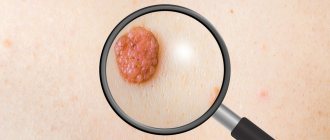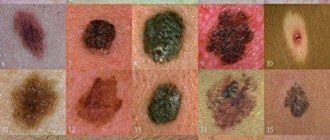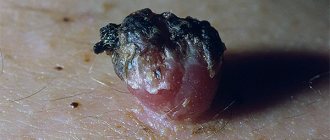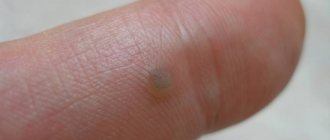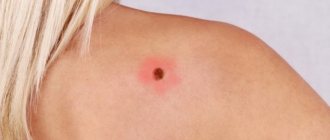Removing a mole is a very unpleasant process that no one wants to face. It’s much worse if the nevus doesn’t just come off, but falls off.
A mole that has fallen off is a reason to go to the hospital as soon as possible, the first alarming symptom of the appearance of a neoplasm (cancerous tumor). To confirm the diagnosis, the growth will be examined and treatment will be prescribed.
Of course, birthmarks on the skin are not a terrible diagnosis in themselves, but if a mole falls off, you should immediately go to the doctor.
Peeling of the crust from a mole
ICD-10 code – D22 Melanoform nevus.
Kinds
A dermatologist can name several types of classifications of moles according to structure, shape, and depth.
It is worth listing the most common types:
- Vascular (hemangioma). This is a pink or red mole in the form of a hanging nodule (sometimes flat).
- Hemangiomas mainly occur in young children, during the formation of the circulatory system. If a red mole begins to grow in an adult, this means that vascular function is impaired, hormonal changes are occurring, or the pancreas or liver is not working well.
- Lengito is the most common type. Pigmented cells are found in the top layer of the skin. Lengitto includes brown and black moles. They are usually not removed. If the color of a mole is initially black, then it is no more dangerous in terms of degeneration than a lighter one.
- Convex. It is formed from melanocytes located in the dermis. The diameter of a convex brown or black mole is no more than 1 cm. Its surface can be smooth or bumpy, often with hair.
- Birthmarks. Most often, they are observed already at birth and represent pigmented areas of the skin. Infants have birthmarks that occupy a large area. They may disappear over time, but require constant attention.
Fighting the bleeding
A mole is bleeding - what to do? Indeed, if nevus injury is so dangerous, it is possible that improper treatment can lead to negative consequences. Leading oncologists advise not to panic and take a number of the following measures:
- treat the wound with hydrogen peroxide. In this case, you should definitely wash your hands with soap, and even better, wear sterile gloves, if you have them in your first aid kit. The cotton wool must be well moistened with the solution so that its fibers do not remain in the wound;
- then proceed to stop the bleeding - tightly fold the gauze or bandage (sterile), apply it to the injury site and press it lightly. Take a comfortable position and wait until the bleeding stops;
- after the bleeding has stopped, treat the wound with any antiseptic - brilliant green, iodine.
Moles sometimes bleed for a long time, and this is not unusual, since each of them consists of a large number of blood vessels that are damaged. In fact, bleeding is absolutely not scary compared to the consequences.
Red moles require special attention - they do not bleed, they can simply be vascular nevi. However, it is better to check them, especially if recently they were the usual brown color.
Causes of a fallen mole
Why did the mole fall off? This can happen for two reasons. Firstly, the nevus may dry out and then fall off.
Most often this happens if a person confuses a mole on his body with a papilloma.
Sometimes the birthmark dies and then falls off. Usually the latter happens if a mole appears due to hormonal imbalance. After the background returns to its place, the nevus may die.
Whatever it is, be sure to consult a doctor. Secondly, the mole may turn black and then fall off. This sign is very bad. Usually those nevi that have begun to degenerate into malignant neoplasms turn black.
If you previously damaged the mole, it may also become darker if there is dried blood there. Even if the nevus has fallen off and there is no redness, inflammation or swelling in its place, you must make an appointment with a doctor.
Can a mole fall off?
Few people know that some nevi can fall off over time. This happens for many reasons. We are so accustomed to the fact that there are a huge number of birthmarks on our body that we don’t even notice them.
Some moles can cause discomfort because they are located in awkward places that often rub against clothing. In such cases, people try to get rid of nevi as quickly as possible.
But it also happens that moles fall off. And this is the first alarm signal, after which you need to immediately go to a dermatologist.
Benign formations and tumors
As an independent phenomenon, moles are a benign formation, which in some cases can transform into a small ticking bomb, ready to turn into a tumor.
The reasons for this behavior include:
a large number of sunburns at a young age;
- frequent exposure to the sun - for example, from eleven o'clock in the morning to four o'clock in the evening. Those who like to get a good tan are at risk. Ultraviolet radiation produced by the sun causes many skin diseases;
- with a love for the solarium. This is also a very serious risk, since a few minutes in it can be equal to a whole day in the sun;
- nevus injury. Even a simply accidentally touched mole can turn into a tumor if damaged;
- disturbances in the functioning of organs responsible for the body’s hormonal levels.
People of Aryan appearance, with fair skin and red hair are most at risk. In pregnant women, the skin is susceptible to the development of new nevi. In general, anyone who has a large number of freckles and moles should be careful going out into the sun. Those whose relatives were sick with a similar disease, as well as those who have suffered many severe sunburns or who have moles that are darker in the center than the edges, should be constantly examined by specialists.
Symptoms of a fallen mole
As a rule, if a mole falls off, this is an alarming signal that changes are occurring in your body. The consequence of this may be the formation of a malignant tumor, so you should immediately consult a doctor.
It is very important to bring at least a small part of the tissue from the fallen mole to the examination in order to conduct histology.
The mole turned black and fell off
Darkening of a mole may mean that this is its standard condition or that changes are occurring in it not for the better. To find out what exactly led to the blackening, you need to contact a specialist.
Nevi are common growths on human skin. Usually they do not cause any harm to the body. But when a mole turns black and falls off (especially if it was old enough), then this is a cause for concern. What reasons could lead to this?
- Hormonal levels change in the body, so a large amount of melanin is produced.
- The blackening occurred after intense tanning.
- Damage to a nevus can also change its color.
The mole dries up and falls off
If you begin to notice that the nevus on your body has begun to dry out and it seems as if it is about to fall off, this is a signal to go to an experienced doctor.
This usually happens if a mole degenerates into melanoma, so it is necessary to make the correct diagnosis and prescribe treatment as early as possible.
Usually, at the site of the mole, the skin begins to peel off, itching appears, and sometimes there may be pain. If you notice these symptoms, make an appointment right away.
The mole has dried up and fallen off
Very often, birthmarks are confused with papillomas, which can dry out and fall off on their own from time to time. But it also happens that a real mole can dry out and fall off. Is it dangerous?
First, you should immediately go to a dermatologist, as this may be the first symptom of the development of melanoma, which in some cases can be fatal. Secondly, it is necessary to take a small part of the tissue from the fallen mole and bring it for histology.
Why does a mole dry out and fall off?
This usually happens if the nevus rubs frequently and intensely against clothing. Sometimes a mole falls off after it dries out if it received too few nutrients.
Pieces fall off the mole
Sometimes it happens that large moles, which have been increasing in size for some time before, fall off. This usually happens after too intense sunbathing, microtrauma, a cut or rubbing.
If pieces of a mole fall off, first of all, don't panic. If possible, you can collect small pieces of the mole and take it for histology.
Also, be sure to see a doctor (oncologist or dermatologist). If the nevus does not become inflamed, does not begin to hurt or itch, then, as a rule, nothing terrible has happened.
The body simply stopped “supplying” nutrients to the nevus, which is why it began to fall off. Of course, there is the possibility of an unpleasant scenario when moles develop into melanoma. Remember that in the early stages this disease is curable.
The mole has dried up and fallen off
Hanging moles often cause discomfort: they can rub against clothes or be unsightly. Sometimes they decide to remove such nevi surgically.
It also happens that the doctor never gets to the point, because the mole dries out and falls off on its own. After this, people usually do not rush to see a specialist.
But this is not the right choice. Be sure to see a dermatologist and bring parts of the fallen mole for laboratory testing.
Sometimes a dry nevus can mean that melanoma has begun to develop in your body.
The mole peels off and falls off
New moles that appear on the body throughout life can be dangerous to our health. Especially if they begin to peel, dry out and fall off.
Remember that any change in the structure of the nevus is the first signal to visit a dermatologist. This may indicate its degeneration into a malignant tumor.
The mole crumbles and falls off
If a mole crumbles and falls off, you should immediately contact an oncologist, as this may mean that it is degenerating into melanoma. In 80% of cases, doctors recommend immediately removing such a formation.
Of course, sometimes it happens that a nevus begins to crumble if the body does not have enough nutrients to support it. In any case, you must first consult with a specialist who will conduct diagnostics and make a diagnosis.
Why does the nevus come off piece by piece?
Can a mole fall off on its own into separate elements? The partial disintegration of a mole may be influenced by the following reasons:
Partial disintegration of the mole is also possible.
- A mole and a solarium are two interrelated phenomena. There is a disturbed blood supply to the nevus, which occurs after intense exposure to UV radiation.
- Malignant transformation of the growth into melanoma. In this case, redness, peeling and soreness of the skin may occur in the place where the nevus has dried out and erupted.
In any of the cases under consideration, the patient must contact an oncologist, who will check the moles and take biological material for histological examination.
Diagnosis of a fallen mole
Usually, if you go to the doctor after your mole has fallen off, the specialist will conduct the following diagnosis:
- Clinical examination of the whole body.
- Dermatoscopy.
- Digital assessment of a mole or neoplasm.
- Map of nevi.
- Biopsy of skin tissue.
Analyzes
The main analysis that is done if a mole falls off is histology. To carry it out, it is necessary to obtain a small amount of tissue from the nevus.
It is placed in a special solution, and the doctor examines the mole under a microscope. This way you can find out whether the spot was malignant melanoma or not.
Instrumental diagnostics
In order to successfully treat a possible melanoma, it is necessary to diagnose it in time. Therefore, if you notice that the nevus has begun to peel off, dry out, or has fallen off, you need to go to the doctor.
Among the popular methods of instrumental diagnosis of moles is dermatoscopy. It is carried out using a dermatoscope, which allows you to enlarge the layers of the skin and see what processes occur under the keratinized epidermis.
Some new clinics are using special digital dermatoscopes that help better diagnose cancer development.
Necessary examination
Adequate treatment can be selected only after a correct diagnosis. It involves taking a smear in the area of formation. Additionally, secretions are taken for examination and a biopsy of the removed area is performed. Oncomerkers are of no small importance. Thanks to them, a conclusion is made about the malignancy of the formation.
To monitor the condition of moles in medical practice, the ACCORD system is used. This method was first proposed in America, and only over time became widespread in our country. The system can be used at home without the help of a specialist in this matter. Thanks to this, the patient will be able to recognize a negative situation at the initial stage of development. During the examination, attention should be paid to the following characteristics:
- presence of asymmetry;
- the nature of the ends of the mole;
- presence of blood stains;
- nature of color distribution;
- changes in size;
- growth intensity.
Treatment of a fallen mole
If you notice that a nevus on your skin has suddenly fallen off on its own, then you first need to make an appointment with a dermatologist. Do not delay visiting your doctor, as this could be life-threatening.
If possible, wrap the mole in paper or cloth to take for testing. Only based on the results of the latter can a specialist determine whether your mole was a malignant neoplasm.
If so, additional surgery may be needed to remove the remaining layers of the nevus. If it was benign, you will need to take some measures to make the place heal faster.
Don’t forget, after a mole falls off, you can’t sunbathe for at least a week.
Medicines
If your mole falls off and the histology results show that it was malignant, treatment will be necessary.
Typically, in the initial stages, melanoma is treated with Interferon-alpha. This drug helps to increase the body's defenses and is exclusively an additional remedy.
It is usually discharged after surgery to remove tumors. This drug helps stop the growth of abnormal cells, which blocks the development of metastases. Since the drug is usually administered in fairly large doses, it may cause side effects.
Reaferon is one of the popular analogues of Interferon-alpha. However, its formula has been slightly improved. The main feature of this remedy is the fact that there are almost no side effects from it. It strengthens the defense system and stops the growth of abnormal cells.
Traditional treatment
Some patients believe that it is best to treat melanoma with folk remedies. It is important to understand that not all medicinal plants are equally helpful in different situations, so consult your doctor first.
One of the most popular remedies used to treat melanoma is the plant aconite. It is poisonous, but precisely because of this it copes well with cancer cells.
A special tincture is created from the tubers of this plant, which is taken before meals three times a day. Remember that you first need to take one drop of tincture, gradually increasing the dose.
To avoid side effects, you should drink herbal tea an hour after taking aconite.
Herbal treatment
If you have a mole that has fallen off and you are worried that it could mean melanoma, but do not want to go to the doctor, you can try to remove the disease from your body using medicinal herbs.
An effective remedy in this case is birch bark. Birch bark contains beta-sitosterol and betulin. There are also essential oils.
Special herbal sets are considered no less popular. But remember that herbs usually help only to prevent the disease, so if you see that a mole on your body has fallen off, you can first drink infusions of nettle, medicinal angelica, hyssop, coriander, and then make an appointment with a doctor.
Homeopathy
Remember that homeopathic medicines only help your body overcome melanoma, but do not cure this disease. That is why it is necessary to take such remedies with special care.
- Galium-heel. It is a popular drug with anti-inflammatory and immunostimulating properties. Suitable for melanoma patients, especially to improve the body's defenses. It comes in the form of drops that are taken orally. The dosage is individual and depends on the specific situation.
- Psori-nohel. It also comes in the form of drops for oral administration. Thanks to this remedy, special processes in the body are stimulated that help fight cancer cells. Suitable for those people who carefully monitor their health, as they are completely safe. The drug removes toxins.
Surgical treatment
After your mole comes off, you need to bring it in for examination. Based on the test results, the doctor will be able to tell whether it was cancerous.
If so, sometimes surgery is necessary to clear the skin of any remnants of the nevus. This is done in several ways, but the most popular is surgical treatment.
It is carried out in a special oncology center. If melanoma is noticed on time and the operation is successful, then in most cases everything ends positively.
What to do next?
After diagnosis, doctors usually prescribe removal of suspicious moles, and every injured nevus becomes just that. Modern medicine offers gentle and safe methods, so you don’t have to worry about the consequences.
The simplest method is surgical excision. It is performed with a scalpel, and the patient is first given local anesthesia. If you follow all the doctor’s recommendations and properly care for the wound, do not rip off the crust and treat the removal site in a timely manner, any inflammatory processes will not affect the patient.
Laser removal is more often used, through which moles are cut off layer by layer to the very base. This procedure takes several minutes. The healing process also occurs quickly and unnoticed.
Based on the results of the histological examination, the doctor will suggest a further strategy of behavior and prescribe treatment, if necessary.
Prevention of malignancy
It is impossible to completely protect yourself from the risk of developing a malignant tumor. Preventive measures help reduce the likelihood. Follow the rules:
- Do not sunbathe during strong solar activity (from 11 to 5 o'clock in the afternoon).
- Visiting the solarium should be moderate.
- Limit skin contact with chemicals.
- Eat healthy foods, avoid dyes and food additives that are dangerous for oncology.
- Carefully examine your body for changes.
- Do not intervene on your own in the process of transformation or modification of a mole.
- When the first alarming symptoms appear, seek help from a doctor.
Timely and high-quality treatment will protect you from serious consequences and prevent further growth of the problem. Do not delay contacting a specialist. The symptoms do not go away without leaving a trace.

